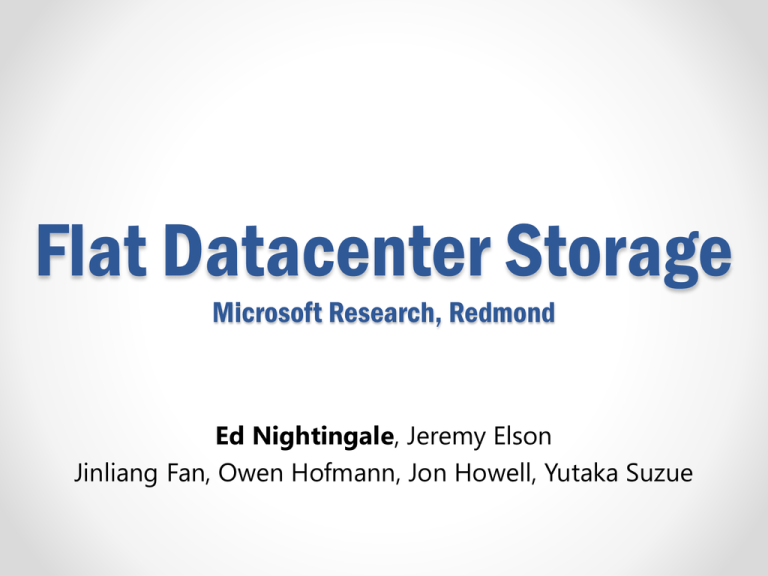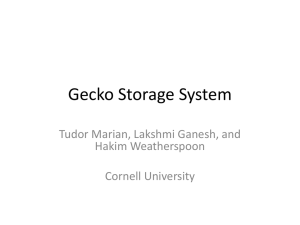fds
advertisement

Flat Datacenter Storage Microsoft Research, Redmond Ed Nightingale, Jeremy Elson Jinliang Fan, Owen Hofmann, Jon Howell, Yutaka Suzue Writing • Fine-grained write striping statistical multiplexing high disk utilization • Good performance and disk efficiency Reading • High utilization (for tasks with balanced CPU/IO) • Easy to write software • Dynamic work allocation no stragglers • Easy to adjust the ratio of CPU to disk resources • Metadata management • Physical data transport FDSOutline in 90 Seconds • FDS is simple, scalable blob storage; logically separate compute and storage without the usual performance penalty • Distributed metadata management, no centralized components on common-case paths • Built on a CLOS network with distributed scheduling • High read/write performance demonstrated (2 Gbyte/s, single-replicated, from one process) • Fast failure recovery (0.6 TB in 33.7 s with 1,000 disks) • High application performance – web index serving; stock cointegration; set the 2012 world record for disk-to-disk sorting Outline • FDS is simple, scalable blob storage; logically separate compute and storage without the usual performance penalty • Distributed metadata management, no centralized components on common-case paths • Built on a CLOS network with distributed scheduling • High read/write performance demonstrated (2 Gbyte/s, single-replicated, from one process) • Fast failure recovery (0.6 TB in 33.7 s with 1,000 disks) • High application performance – set the 2012 world record for disk-to-disk sorting 8 MB Blob 0x5f37...59df: Tract 0 Tract 1 Tract 2 ... Tract n // create a blob with the specified GUID CreateBlob(GUID, &blobHandle, doneCallbackFunction); //... // Write 8mb from buf to tract 0 of the blob. blobHandle->WriteTract(0, buf, doneCallbackFunction); // Read tract 2 of blob into buf blobHandle->ReadTract(2, buf, doneCallbackFunction); Client Clients Network Metadata Server Tractservers Outline • FDS is simple, scalable blob storage; logically separate compute and storage without the usual performance penalty • Distributed metadata management, no centralized components on common-case paths • Built on a CLOS network with distributed scheduling • High read/write performance demonstrated (2 Gbyte/s, single-replicated, from one process) • Fast failure recovery (0.6 TB in 33.7 s with 1,000 disks) • High application performance – set the 2012 world record for disk-to-disk sorting GFS, Hadoop – – – + + + + Centralized metadata server On critical path of reads/writes Large (coarsely striped) writes Complete state visibility Full control over data placement One-hop access to data Fast reaction to failures FDS DHTs + + – – No central bottlenecks Highly scalable Multiple hops to find data Slower failure recovery Metadata Server Tract Locator Table Client Locator Disk 1 Disk 2 Disk 3 0 A B C 1 A D F 2 A 3 D 4 … O(n) or O(n2) OracleC E B C • Consistent … … • Pseudo-random 1,526 LM TH G G F … Tractserver Addresses (Readers use one; Writers use all) JE (hash(Blob_GUID) + Tract_Num) MOD Table_Size (hash(Blob_GUID) + Tract_Num) MOD Table_Size —1 = Special metadata tract Outline • FDS is simple, scalable blob storage; logically separate compute and storage without the usual performance penalty • Distributed metadata management, no centralized components on common-case paths • Built on a CLOS network with distributed scheduling • High read/write performance demonstrated (2 Gbyte/s, single-replicated, from one process) • Fast failure recovery (0.6 TB in 33.7 s with 1,000 disks) • High application performance – set the 2012 world record for disk-to-disk sorting Bandwidth is (was?) scarce in datacenters due to oversubscription Network Core 10x-20x Top-Of-Rack Switch CPU Rack Bandwidth is (was?) scarce in datacenters due to oversubscription CLOS networks: [Al-Fares 08, Greenberg 09] full bisection bandwidth at datacenter scales Bandwidth is (was?) scarce in datacenters due to oversubscription CLOS networks: [Al-Fares 08, Greenberg 09] full bisection bandwidth at datacenter scales 4x-25x Disks: ≈ 1Gbps bandwidth each Bandwidth is (was?) scarce in datacenters due to oversubscription CLOS networks: [Al-Fares 08, Greenberg 09] full bisection bandwidth at datacenter scales FDS: Provision the network sufficiently for every disk: 1G of network per disk • ~1,500 disks spread across ~250 servers • Dual 10G NICs in most servers • 2-layer Monsoon: o o o o Based on Blade G8264 Router 64x10G ports 14x TORs, 8x Spines 4x TOR-to-Spine connections per pair 448x10G ports total (4.5 terabits), full bisection No Silver Bullet X • Full bisection bandwidth is only stochastic o Long flows are bad for load-balancing o FDS generates a large number of short flows are going to diverse destinations • Congestion isn’t eliminated; it’s been pushed to the edges o TCP bandwidth allocation performs poorly with short, fat flows: incast • FDS creates “circuits” using RTS/CTS Outline • FDS is simple, scalable blob storage; logically separate compute and storage without the usual performance penalty • Distributed metadata management, no centralized components on common-case paths • Built on a CLOS network with distributed scheduling • High read/write performance demonstrated (2 Gbyte/s, single-replicated, from one process) • Fast failure recovery (0.6 TB in 33.7 s with 1,000 disks) • High application performance – set the 2012 world record for disk-to-disk sorting Read/Write Performance Single-Replicated Tractservers, 10G Clients Read: 950 MB/s/client Write: 1,150 MB/s/client Read/Write Performance Triple-Replicated Tractservers, 10G Clients Outline • FDS is simple, scalable blob storage; logically separate compute and storage without the usual performance penalty • Distributed metadata management, no centralized components on common-case paths • Built on a CLOS network with distributed scheduling • High read/write performance demonstrated (2 Gbyte/s, single-replicated, from one process) • Fast failure recovery (0.6 TB in 33.7 s with 1,000 disks) • High application performance – set the 2012 world record for disk-to-disk sorting X Hot Spare More disks faster recovery Locator Disk 1 Disk 2 Disk 3 1 A B C 2 A C Z 3 A D H 4 A E M 5 A F C 6 A G P … … … … 648 Z W H 649 Z X L 650 Z Y C • All disk pairs appear in the table • n disks each recover 1/nth of the lost data in parallel Locator Disk 1 Disk 2 Disk 3 1 A M B C 2 A S C Z 3 A R D H 4 A D E M 5 A S F C 6 A N G P … … … … 648 Z W H 649 Z X L 650 Z Y C • All disk pairs appear in the table • n disks each recover 1/nth of the lost data in parallel Locator Disk 1 Disk 2 Disk 3 B C 2 A S C Z 3 A R D H 4 A D E M 5 A S F G 6 A N G P … … … … 648 Z W H 649 Z X L 650 Z Y C 1 M S C 2 H 1 R 3 • All disk pairs appear in the table • n disks each recover 1/nth of the lost data in parallel … A M … 1 B Failure Recovery Results Disks in Cluster Disks Failed Data Recovered Time 100 1 47 GB 19.2 ± 0.7s 1,000 1 47 GB 3.3 ± 0.6s 1,000 1 92 GB 6.2 ± 6.2s 1,000 7 655 GB 33.7 ± 1.5s • We recover at about 40 MB/s/disk + detection time • 1 TB failure in a 3,000 disk cluster: ~17s Failure Recovery Results Disks in Cluster Disks Failed Data Recovered Time 100 1 47 GB 19.2 ± 0.7s 1,000 1 47 GB 3.3 ± 0.6s 1,000 1 92 GB 6.2 ± 6.2s 1,000 7 655 GB 33.7 ± 1.5s • We recover at about 40 MB/s/disk + detection time • 1 TB failure in a 3,000 disk cluster: ~17s Outline • FDS is simple, scalable blob storage; logically separate compute and storage without the usual performance penalty • Distributed metadata management, no centralized components on common-case paths • Built on a CLOS network with distributed scheduling • High read/write performance demonstrated (2 Gbyte/s, single-replicated, from one process) • Fast failure recovery (0.6 TB in 33.7 s with 1,000 disks) • High application performance – set the 2012 world record for disk-to-disk sorting Minute Sort • Jim Gray’s benchmark: How much data can you sort in 60 seconds? o Has real-world applicability: sort, arbitrary join, group by <any> column System MSR FDS 2012 Yahoo! Hadoop 2009 Computers Disks Sort Size Time Disk Throughput 256 1,033 1,470 GB 59 s 46 MB/s 1,408 5,632 500 GB 59 s 3 MB/s 15x efficiency improvement! • Previous “no holds barred” record – UCSD (1,353 GB); FDS: 1,470 GB o Their purpose-built stack beat us on efficiency, however • Sort was “just an app” – FDS was not enlightened o Sent the data over the network thrice (read, bucket, write) o First system to hold the record without using local storage Dynamic Work Allocation Conclusions • Agility and conceptual simplicity of a global store, without the usual performance penalty • Remote storage is as fast (throughput-wise) as local • Build high-performance, high-utilization clusters o Buy as many disks as you need aggregate IOPS o Provision enough network bandwidth based on computation to I/O ratio of expected applications o Apps can use I/O and compute in whatever ratio they need o By investing about 30% more for the network and use nearly all the hardware • Potentially enable new applications Thank you! FDS Sort vs. TritonSort System Computers Disks Sort Size Time Disk Throughput FDS 2012 256 1,033 1,470GB 59.4s 47.9MB/s TritonSort 2011 66 1,056 1,353GB 59.2s 43.3MB/s • Disk-wise: FDS is more efficient (~10%) • Computer-wise: FDS is less efficient, but … o Some is genuine inefficiency – sending data three times o Some is because FDS used a scrapheap of old computers • Only 7 disks per machine • Couldn’t run tractserver and client on the same machine • Design differences: o General-purpose remote store vs. purpose-built sort application o Could scale 10x with no changes vs. one big switch at the top Hadoop on a 10G CLOS network? • Congestion isn’t eliminated; it’s been pushed to the edges o TCP bandwidth allocation performs poorly with short, fat flows: incast o FDS creates “circuits” using RTS/CTS • Full bisection bandwidth is only stochastic • Software written to assume bandwidth is scarce won’t try to use the network • We want to exploit all disks equally Stock Market Analysis • Analyzes stock market data from BATStrading.com • 23 seconds to o Read 2.5GB of compressed data from a blob o Decompress to 13GB & do computation o Write correlated data back to blobs • Original zlib compression thrown out – too slow! o FDS delivered 8MB/70ms/NIC, but each tract took 218ms to decompress (10 NICs, 16 cores) o Switched to XPress, which can decompress in 62ms • FDS turned this from an I/O-bound to compute-bound application FDS Recovery Speed: Triple-Replicated, Single Disk Failure 2012 Result: 1,000 disks, 92GB per disk, 2010 Estimate: recovered in 6.2 +/- 0.4 sec 2,500-3,000 disks, 1TB per disk, should recover in 30 sec 2010 Experiment: 98 disks, 25GB per disk, recovered in 20 sec Why is fast failure recovery important? • Increased data durability o Too many failures within a recovery window = data loss o Reduce window from hours to seconds • Decreased CapEx+OpEx o CapEx: No need for “hot spares”: all disks do work o OpEx: Don’t replace disks; wait for an upgrade. • Simplicity o Block writes until recovery completes o Avoid corner cases FDS Cluster 1 • • • • 14 machines (16 cores) 8 disks per machine ~10 1G NICs per machine 4x LB4G switches o 40x1G + 4x10G • 1x LB6M switch o 24x10G Made possible through the generous support of the eXtreme Computing Group (XCG) Cluster 2 Network Topology Distributing 8mb tracts to disks uniformly at random: How many tracts is a disk likely to get? 60GB, 56 disks: μ = 134, σ = 11.5 Likely range: 110-159 Max likely 18.7% higher than average Distributing 8mb tracts to disks uniformly at random: How many tracts is a disk likely to get? 500GB, 1,033 disks: μ = 60, σ = 7.8 Likely range: 38 to 86 Max likely 42.1% higher than average Solution (simplified): Change locator to (Hash(Blob_GUID) + Tract_Number) MOD TableSize








